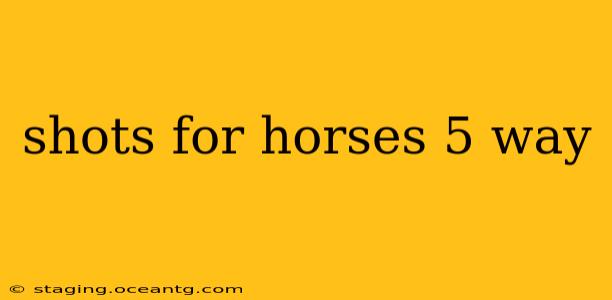5 Essential Shots for Photographing Horses: Mastering Equine Photography
Capturing the power, grace, and spirit of a horse through photography requires more than just pointing and shooting. Understanding the best angles and techniques is crucial for creating truly stunning images. This guide focuses on five essential shots that will elevate your equine photography, whether you're a seasoned professional or just starting out. We'll explore composition, lighting, and capturing the horse's personality in each shot.
1. The Classic Headshot: Emphasizing Details and Expression
The headshot, often considered the quintessential equine portrait, focuses on the horse's head and upper neck. This shot allows you to highlight the animal's unique features, such as its eyes, ears, and muzzle.
Tips for Success:
- Get Down to Eye Level: Position yourself at or slightly below the horse's eye level to create a more intimate and engaging portrait. Shooting from above can make the horse appear smaller and less powerful.
- Focus on the Eyes: The eyes are the windows to the soul, and this is especially true for horses. Ensure they are sharp and in focus; a slightly blurred eye can ruin an otherwise perfect shot.
- Lighting is Key: Soft, diffused light is ideal for headshots. Harsh midday sun can create unflattering shadows. The “golden hour” (sunrise and sunset) often provides beautiful, warm light.
- Capture Personality: A relaxed, curious, or alert expression will significantly enhance your image. Be patient and let the horse settle before taking the shot.
2. The Profile Shot: Showcasing Conformation and Movement
A profile shot captures the horse from the side, showcasing its body conformation and overall elegance. This is a great way to highlight muscle definition, coat texture, and the horse’s overall build.
Tips for Success:
- Background Matters: Choose a clean, uncluttered background to prevent distractions from the horse. A natural setting, like a field or pasture, often works well.
- Consider Movement: If possible, capture the horse in motion—a gentle trot or walk—to add dynamism to the image. A slightly blurred background can further emphasize the horse.
- Angle is Important: Experiment with slightly higher or lower angles to create different perspectives and enhance the horse's form.
3. The Action Shot: Freezing Motion and Energy
Action shots are all about capturing the horse's power and athleticism in mid-stride. This shot requires a fast shutter speed to freeze the motion.
Tips for Success:
- Fast Shutter Speed: Use a shutter speed of at least 1/500th of a second, or even faster, depending on the speed of the horse.
- Burst Mode: Utilize your camera's burst mode to capture multiple images in quick succession, increasing your chances of getting the perfect shot.
- Anticipate the Movement: Pay close attention to the horse's movement to predict when to take the shot.
4. The Full-Body Shot: Showing Scale and Proportion
This shot captures the entire horse from head to tail, showcasing its scale and overall proportions. It's excellent for highlighting a particular breed's characteristics or a horse's individual conformation.
Tips for Success:
- Wide Angle Lens: A wide-angle lens might be necessary to capture the entire horse, especially if you are close to the animal.
- Positioning: Position yourself so the horse is slightly angled towards the camera to avoid a completely stiff, frontal pose.
- Environmental Context: Consider including a portion of the environment in your full-body shot to add context and depth.
5. The Candid Shot: Capturing Natural Behavior
Candid shots capture the horse in its natural environment, exhibiting spontaneous behaviors. This type of photography often yields the most genuine and emotive images.
Tips for Success:
- Patience is Key: You need patience to capture candid moments. Spend time observing the horse's behavior and wait for the right moment to take the shot.
- Natural Lighting: Opt for natural light for a more authentic feel.
- Be Unobtrusive: Try to be as unobtrusive as possible, avoiding any actions that might startle or disturb the horse.
By mastering these five essential shots, you'll be well on your way to creating a captivating portfolio of equine photography. Remember to practice, experiment with different angles and settings, and most importantly, have fun! The beauty of equine photography lies in capturing the unique spirit of each horse.
